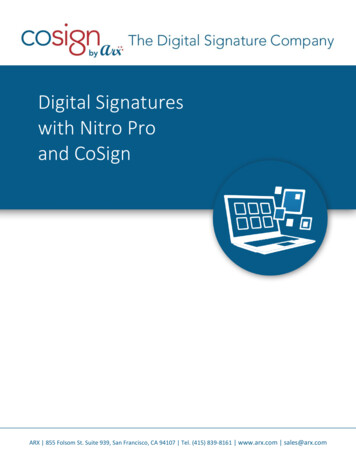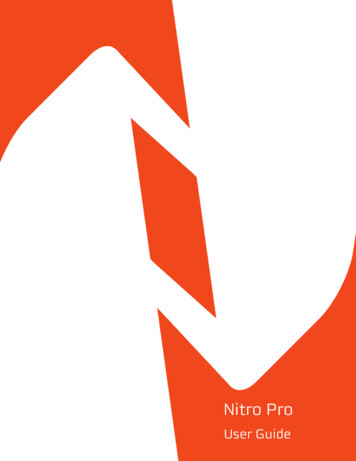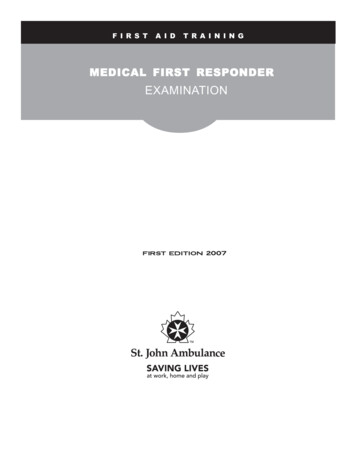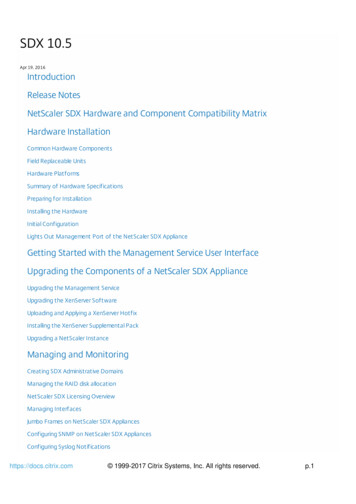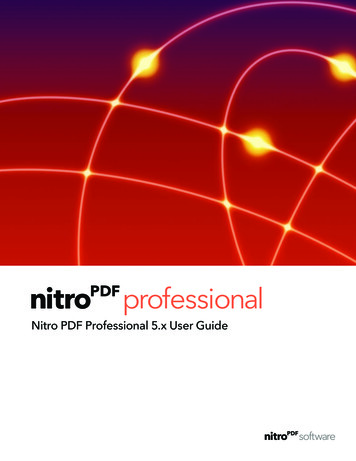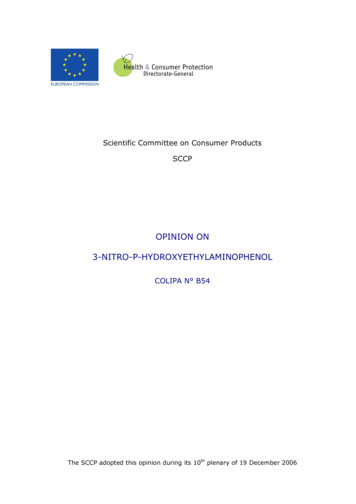
Transcription
Scientific Committee on Consumer ProductsSCCPOPINION ON3-NITRO-P-HYDROXYETHYLAMINOPHENOLCOLIPA N B54The SCCP adopted this opinion during its 10th plenary of 19 December 2006
OPINION ON 3-NITRO-P-HYDROXYETHYLAMINOPHENOLSCCP/1036/06About the Scientific CommitteesThree independent non-food Scientific Committees provide the Commission with thescientific advice it needs when preparing policy and proposals relating to consumer safety,public health and the environment. The Committees also draw the Commission's attentionto the new or emerging problems which may pose an actual or potential threat.They are: the Scientific Committee on Consumer Products (SCCP), the Scientific Committeeon Health and Environmental Risks (SCHER) and the Scientific Committee on Emerging andNewly Identified Health Risks (SCENIHR) and are made up of external experts.In addition, the Commission relies upon the work of the European Food Safety Authority(EFSA), the European Medicines Evaluation Agency (EMEA), the European Centre forDisease prevention and Control (ECDC) and the European Chemicals Agency (ECHA).SCCPQuestions concerning the safety of consumer products (non-food products intended for theconsumer).In particular, the Committee addresses questions related to the safety and allergenicproperties of cosmetic products and ingredients with respect to their impact on consumerhealth, toys, textiles, clothing, personal care products, domestic products such asdetergents and consumer services such as tattooing.Scientific Committee membersClaire M. Chambers, Gisela Degen, Ruta Dubakiene, Ramon Grimalt, Bozena JazwiecKanyion, Vassilios Kapoulas, Jean Krutmann, Carola Lidén, Jean-Paul Marty, ThomasPlatzek, Suresh C. Rastogi, Jean Revuz, Vera Rogiers, Tore Sanner, Günter Speit, Jacquelinevan Engelen, Ian R. WhiteContact:European CommissionHealth & Consumer Protection DGDirectorate C: Public Health and Risk AssessmentUnit C7 - Risk AssessmentOffice: B232B-1049 BrusselsSanco-Sc6-Secretariat@ec.europa.eu European Commission 2007The opinions of the Scientific Committees reflect the views of the independent scientistswho are members of the committees. They do not necessarily reflect the views of theEuropean Commission. The opinions are published by the European Commission in theiroriginal language only.http://ec.europa.eu/health/ph risk/risk en.htm2
OPINION ON WLEDGEMENTSMembers of the working group are acknowledged for their valuable contribution to thisopinion. The members of the working group are:Dr. C. ChambersProf. V. KapoulasProf. C. LidénProf. J.-P. MartyProf. T. PlatzekDr. S.C. RastogiProf. T. SannerDr. J. van EngelenDr. I.R. White(chairman)(rapporteur)External expertsDr.Dr.Dr.Dr.M.-L. BinderupH. NorppaK. PeltonenJ. van BenthemNational Food Institute, DenmarkFinnish Institute of Occupational Health, FinlandEVIRA, FinlandRIVM, the NetherlandsKeywords: SCCP, scientific opinion, hair dye, 3-nitro-p-hydroxyethylaminophenol, B54,Directive 768/76/EEC, CAS 65235-31-6Opinion to be cited as:Scientific Committee on Consumer Products (SCCP), 19 December 2006, Opinion on 3nitro-p-hydroxyethylaminophenol COLIPA n B543
OPINION ON 3-NITRO-P-HYDROXYETHYLAMINOPHENOLSCCP/1036/06TABLE OF CONTENTSACKNOWLEDGEMENTS. 31.BACKGROUND. 52.TERMS OF REFERENCE . 53.OPINION . 54.CONCLUSION. 235.MINORITY OPINION . 246.REFERENCES . 244
OPINION ON KGROUNDSubmission I for ted in March 1992 byThe Scientific Committee on Cosmetology (SCC) expressed its opinion SPC/1075/93 at the53rd plenary meeting of 25 June 1993 with the conclusion that the substance is safe(Classification A).The substance is currently regulated by the Cosmetics Directive (76/768/EC), Annex III,Part 2 under entry 48 on the Preliminary list of substances, which cosmetic products mustnot contain except subject to restrictions and conditions laid down.According to current submission II, submitted by COLIPA in July 2005, 3-NITRO-Pis used in oxidative hair colouring products at a maximum onhead concentration of 3%, after mixing the hair dye formulation with hydrogen peroxidetypically in 1:1 proportions. 3-NITRO-P-HYDROXYETHYLAMINOPHENOL IS ALSO USED IN SEMIPERMANENT hair colouring products at a maximum concentration of 1.85%.HYDROXYETHYLAMINOPHENOLSubmission III presents updated scientific data on the above mentioned substance in linewith the second step of the strategy for the evaluation of hair smetics/doc/hairdyestrategyinternet.pdf)the framework of the Cosmetics Directive 76/768/EEC.2.TERMS OF REFERENCE1.Does the Scientific Committee on Consumer Products (SCCP) consider 3-nitro-phydroxyethylaminophenol safe for use as an ingredient in both oxidative hair dyes andnon-oxidative hair dye formulations with a concentration on-head of maximum 3.0%respectively 1.85% taking into account the scientific data provided?2.Does the SCCP recommend any restrictions with regard to the use of 3-nitro-phydroxyethylaminophenol in both oxidative hair dyes and non-oxidative hair dyeformulations?3.OPINION3.1. Chemical and Physical Specifications3.1.1.Chemical identity3.1.1.1.Primary name and/or INCI name3-Nitro-p-hydroxyethylaminophenol (INCI)3.1.1.2.Chemical namesPhenol, 4-[(2-hydroxyethyl)amino)]-3-nitro nzene1COLIPA - European Cosmetics Toiletry and Perfumery Association5
SCCP/1036/06OPINION ON 3-NITRO-P-HYDROXYETHYLAMINOPHENOL3.1.1.3.Trade names and abbreviationsIMEXINE FHCOLIPA n B0543.1.1.4.CAS / EINECS ural l formulaC8H10N2O4Physical formGreenish-brown powder3.1.3.Molecular weightMolecular weight:3.1.4.198.18Purity, composition and substance codesPurity and impurities in various batches of ation/characterisationMelting pointTitre (g/100g)HPLC purity(% peak area)Impurities3 (g/100 g)ABCWater content (g/100g)Solvent residues (ppm)IsopropanolMethanol*123Batch0509151UV-Vis, IR, NMR, MS, elementalanalysis133 C98.3198.5Op.108*Visible spectrum is comparable139 C98.720.140.520.110.3 100, detected 100, detectedOnly certificate of analysis (without signature), no supporting dataNeutralisation of amine function with perchloric acid in acetic acid mediumdeterminationSpectrophotometric determination at 475 nmImpurities:6
OPINION ON xy)ethyl]amino}-3-nitrophenolImpurities / accompanying contaminantsSee 3.1.43.1.6.SolubilityWater:Ethanol:DMSO:1.06 0.07 g/l, at 20 C 0.5 C 1 g/100 ml, 10 g/100 ml 20g/100 ml3.1.7.Partition coefficient (Log Pow)Log Pow:3.1.8.Additional physical and chemical specifications0.60 (at 23 C 2 C, pH 7.45)Organoleptic properties:Melting point:Boiling point:Flash point:Vapour pressure:Density:Viscosity:pKa:Refractive index:UV-Vis spectrum:3.1.9./133 C -139 C///////Absorption maxima at 237.2 nm and 477 nmStability and Homogeneity1 mg/ml and 200 mg/ml solutions of 3-Nitro-p-hydroxyethylaminophenol in 0.5%carboxymethylcellulose (CMC), at room temperature up to 6 hours and up to 9 days at4 C, were stable (maximum deviation from initial concentration 4%) when storedprotected from light and under inert atmosphere.0.1 mg/ml and 500 mg/ml solutions of 3-Nitro-p-hydroxyethylaminophenol in DMSO werestable at room temperature up to 4 hours study period (maximum deviation from initialconcentration 1%) when stored protected from light and under inert gas atmosphere.1.0 mg/ml, 10 mg/ml and 500 mg/ml solutions of 3-Nitro-p-hydroxyethylaminophenol inDMF were stable at room temperature up to 4 hours study period (maximum deviation frominitial concentration 3%) when stored protected from light and under inert gasatmosphereThe solutions of 3-Nitro-p-hydroxyethylaminophenol in 0.5% CMC were found to behomogeneous during the 9 days storage period (CV maximum 5%) at when stored at 4 C,protected from light and under inert gas atmosphere.General comments to physico-chemical characterisation7
OPINION ON tro-p-hydroxyethylaminophenol is a secondary amine, and thus, it is prone tonitrosation. Nitrosamine content in 3-nitro-p-hydroxyethylaminophenol is notreported.No supporting data is provided for the chemical characterisation of 3-Nitro-phydroxyethyl-aminophenol, Batch Op. 108.Stability of 3-Nitro-p-hydroxyethylaminophenol in marketed products is not reported3.2. Function and usesThe ingredient 3-nitro-p-hydroxethylaminophenol is used in oxidative hair colouringproducts at a maximum on-head concentration of 3%, after mixing the hair dye formulationwith hydrogen peroxide typically in 1:1 proportions. 3-Nitro-p-hydroxethylaminophenol isalso used in semi-permanent hair colouring products at a maximum concentration of1.85%.3.3. Toxicological Evaluation3.3.1.Acute toxicity3.3.1.1.Acute oral toxicityGuideline:Species/strain:Test substance:Batch:Purity:Vehicle:GLP:Partly in compliance with OECD 420Rat, 15198.5%0.5% suspension of carboxymethylcellulose in purified waterIn complianceIn an acute oral toxicity study, the single oral administration (by gavage) of 3-nitro-phydroxethylaminophenol to female Sprague-Dawley rats at the dose of 2000 mg/kgresulted in death in 2/5 animals within 4 hours following the treatment. Hypoactivity,piloerection, lateral recumbency and dyspnoea were observed prior to death of theseanimals and in surviving animals on day 1. No mortality occurred at the dose of 1000mg/kg and piloerection was noted on the day of dosing in all animals. No effects on bodyweight and no macroscopic abnormalities were observed at either dose level. In summary, anon-lethal dose of 3-nitro-p-hydroxethylaminophenol was 1000 mg/kg and a lethal dosewas 2000 mg/kg in rats.Ref.: 1CommentAccording to Annex 3 of OECD guideline 420, the second dose level should have been 300mg/kg instead of 1000 mg/kg. Despite this deficiency, this study is useful for evaluation.3.3.1.2.Acute dermal toxicityNo data submitted3.3.1.3.Acute inhalation toxicityNo data submitted8
OPINION ON 3-NITRO-P-HYDROXYETHYLAMINOPHENOL3.3.2Irritation and corrosivity3.3.2.1.Skin Purity:Dose:GLP:SCCP/1036/06OECD 404New Zealand White rabbits3 0.5ml of 6 % 3-nitro-p-hydroxyethylaminophenol in a 0.5% suspension ofcarboxymethylcellulose in purified waterin compliance0.5 ml of 6 % 3-nitro-p-hydroxyethylaminophenol in 0.5% carboxymethylcellulose wasapplied for periods of 3 minutes, 1 hour and 4 hours to a single male New Zealand Whiterabbit. The substance was held in contact with the skin by means of a semi-occlusivedressing. Cutaneous reactions were observed approximately 1 hour, 24, 48 and 72 hoursafter removal of the dressing and then daily until the end of the observation period.Since persistent red coloration of the skin was noted in this animal, the study was thenextended to include two additional animals by applying the test substance for 4 hours to theclipped flank. Observations for any cutaneous reaction were made at approximately 1 hour,24, 48 and 72 hours after removal of the dressing.Because of the discoloration, the animals were killed and skin samples were taken from theflanks of the animals (treated and untreated sites) for histological examination.ResultsThe red discoloration may have masked any erythema. No associated cutaneous reactions(dryness of the skin, crusts or oedema) were observed.The microscopic examination of the last two treated animals did not show any changeswhich could be attributable to the treatment with the test item.ConclusionUnder the conditions of the study 6 % 3-nitro-p-hydroxyethylaminophenol, was not irritantto rabbit skin.Ref.: urity:Dose:GLP:Mucous membrane irritationOECD 405New Zealand White rabbits3 0.1ml of 6 % 3-nitro-p-hydroxyethylaminophenol in a 0.5% suspension ofcarboxymethylcellulose in purified waterin compliance0.1 ml of 6 % 3-nitro-p-hydroxyethylaminophenol in 0.5% carboxymethylcellulose wasinstilled into the left conjunctival sac; the right eyes served as the controls.Observations were made at 1, 24, 48 and 72 hours and the daily until day 7.Results9
OPINION ON t chemosis and very slight conjunctival redness in all animals from day 1 up to day 4after instillation. No other ocular lesions were observed during the study.ConclusionUnder the conditions of the test 6 % 3-nitro-p-hydroxyethylaminophenol is irritant to rabbiteyes.Ref.: 33.3.3.Skin sensitisationLocal Lymph node y:Dose:GLP:OECD 429female mice, CBA/J7 groups of 4 mice (28 animals) for each of 2 198.3%25 of 3-nitro-p-hydroxyethylaminophenol 2.5, 5, 10, 25 and 50% indimethylformamide (first experiment)25 µl 3-nitro-p-hydroxyethylaminophenol 0.03, 0.09, 0.28, 0.83 and 2.5%in dimethylformamide (second experiment)in complianceA Local Lymph Node Assay was conducted in female CBA/J mice to investigate thesensitisation potential of 3-nitro-p-hydroxyethylaminophenol. The dose volume of 25 µL 3nitro-p-hydroxyethylaminophenol in dimethylformamide was applied to the dorsal surface ofboth ears at the following concentrations: 2.5%, 5%, 10%, 25% and 50%. As positivelymphoproliferative responses were obtained at all these concentrations, a secondexperiment using the concentrations of 0.03%, 0.09%, 0.28%, 0.83% and 2.5% 3-nitro-phydroxyethylaminophenol was performed.A positive control group received 25% alpha-hexylcinnamaldehyde (HCA) indimethylformamide and the negative control the vehicle alone.In each experiment, during the induction phase, the test item, vehicle or positive controlwas applied over the ears (25 µl per ear) for 3 consecutive days (days 1, 2 and 3). After 2days of resting, the proliferation of lymphocytes in the lymph node draining the applicationsite was measured by incorporation of tritiated methyl thymidine (day 6). The obtainedvalues were used to calculate stimulation indices (SI).ResultsNo mortality, clinical signs or compound-related changes in body weight were observed ineither experiment. Red colouration of ear skin that could have masked discrete to severeerythema was observed in both experiments, but because no increase in ear thickness wasnoted, it was considered that 3-nitro-p-hydroxyethylaminophenol produced no excessivelocal irritation.In the first experiment, positive lymphoproliferative responses occurred with no clearrelationship to dose.TreatmentTest itemTest itemTest itemTest itemTest itemHCAConcentration (%)2.5510255025Signs of local irritationnonononono-10Stimulation Index (SI)14.6223.8814.0122.024.626.76
OPINION ON 3-NITRO-P-HYDROXYETHYLAMINOPHENOLSCCP/1036/06In the second experiment, a dose-related increase in stimulation index was observed, andthe threshold positive value of 3 was exceeded at concentrations 0.09%.TreatmentTest itemTest itemTest itemTest itemTest itemHCAConcentration (%)0.030.090.280.832.525Signs of local irritationnonononononoStimulation Index (SI)2.183.546.367.6111.227.34The EC3 value (0.07%) indicated 3-nitro-p-hydroxyethylaminophenol should be consideredas an extreme sensitiser in mice.Conclusion3-nitro-p-hydroxyethylaminophenol is an extreme sensitiser in the murine Local LymphNode Assay.Ref.: 43.3.4.Dermal / percutaneous absorptionIn vitro Percutaneous Purity:Radiolabelled:Batch:Purity:Dose:GLP:OECD draft 428Humanfemales, (2 abdominal skin and 4 breast skin)3-nitro-p-hydroxyethylaminophenol )[ring-U-14C]phenolCFQ130999.5%20 mg/cm2 of test formulations containing a) 3% w/w test substance inoxidative conditions or b) 1.85% w/w as a semi-permanent dye.in complianceThe in vitro percutaneous absorption of 3-nitro-p-hydroxyethylaminophenol from two typicalhair colouring products was determined under “in-use” conditions, in human dermatomedskin mounted in flow-through diffusion cells, using phosphate buffered saline containingserum bovine albumin at 5% (w/w).The integrity of skin samples was assessed by the tritiated water permeability coefficient.From these, samples were chosen which had a Kp of 2.5 x 10-3 cm.h-1.Under oxidative conditions, 3-nitro-p-hydroxyethylaminophenol was incorporated into atypical oxidative hair dye formulation at 6% (w/w) before mixing with developer (hydrogenperoxide, 1:1, w/w) to give a final concentration of 3%.Under semi-permanent conditions, 3-nitro-p-hydroxyethylaminophenol was incorporatedinto a typical semi-permanent hair dye formulation at 1.85% (w/w).Approximately 20 mg/cm2 of each test formulation was applied to the skin surface. After 30minutes of exposure, the hair dye remaining on the skin surface was removed by washing.Twenty-four (24) hours after application, the cutaneous distribution of 3-nitro-phydroxyethylaminophenol was assessed by Liquid Scintillation Counting in the skin washes(dislodgeable dose), stratum corneum (isolated by tape strippings), skin (living epidermisplus dermis) and receptor fluid.11
OPINION ON tsA total of 12 samples of human skin obtained from 4 different donors were dosed topicallywith [14C]-NPHEAP in the oxidative test preparation of a hair dye formulation (3%, w/w).Cell 1 was rejected from the mean and SD as the mass balance was too low.A total of 12 samples of human skin obtained from 5 different donors were dosed topicallywith of [14C]-NPHEAP in the semi-permanent test preparation (1.85% w/w).Cell 33 was rejected as this has an absorbed dose value out with mean plus 2SD.The dermal absorption (sum of the amounts measured in the living epidermis, dermis andreceptor fluid) was 2.50 2.14 µgeq/cm² (0.40%) and 0.45 0.31 µgeq/cm² (0.12%) inoxidative and semi-permanent conditions, respectivelyConclusionThe maximum absorption values of 8.21 µgeq/cm² in oxidative and of 1.10 µgeq/cm²(excluding cell 33) in semi-permanent conditions will be used for the calculation of the MoS.Ref.: 123.3.5.Repeated dose toxicity3.3.5.1.Repeated Dose (28 days) oral / dermal / inhalation toxicityNo data submitted3.3.5.2.Sub-chronic (90 days) oral / dermal / inhalation toxicityGuideline:Species/strain:Group size:Test substance:Batch:Purity:Dose levels:/Rat, Sprague-Dawley10 animals per sex and doseImexine FHOP.108100%0, 40, 200 and 1000 mg/kg bw/day12
OPINION ON ing 80and0.5gsodiumcarboxymethylcellulose in 100 ml sterile water containing 0.01%activated dimethiconeOral, by oesophageal gavage7days/week for 96 days (males) or 97 days (females)In complianceIn a 3 month toxicity study the hair dye Imexine FH was administered to the rat by the oralroute (oesophageal gavage) as a suspension in a volume of 5 ml/kg at doses of 40, 200 and1000 mg/kg/day, seven days a week for three months (10 animals of each sex per dose). Acontrol group of similar composition received the vehicle. Ophthalmologic, haematologic,blood biochemistry and urine evaluations were performed after 4 and 13 weeks oftreatment. The animals were killed and autopsied; macroscopic and microscopic evaluationsof principal organs were performed.No mortality was observed. The fur and urine of the animals were stained red as of the firsttreatment and the intensity of the discolouration was a function of the dose administered.Ptyalism appeared at the dose of 1000 mg/kg/day, immediately after productadministration, as of the seventh week of treatment. Body weight gain and foodconsumption were slightly decreased (7%) in males at the low dose; no change wasobserved at other doses. The ophthalmologic examinations performed in high dose animalsrevealed a slight yellow-orange discolouration of the choroid attributable to that of thesclera, without alteration of the appearance of the choroid vessels. The slight modificationsobserved in the haematology, blood biochemistry and urinalysis evaluations were withouttoxicological significance. Organ weights in both sexes revealed a slight increase in liver andkidney weights (less than 20% in relation to 100 g body weight) without pathologicalsignificance. Dark discolouration of the thyroids in 7/10 males at 1000 mg/kg/day observedat necropsy was identified microscopically as finely granular lipofuscin or melanin pigmentsin the thyroid follicles.ConclusionThe oral administration of the product Imexine FH to the rat for three months at doses of40, 200 and 1000 mg/kg/day caused no modifications in organs with the exception ofpigment deposition in thyroid follicles of most of the males treated at the high dose.According to the authors, this abnormality does not constitute a toxicological alteration andthe dose of 1000 mg/kg/day administered under the conditions described can thus beconsidered as a dose without toxic effect. Accordingly, the NOAEL was set at 1000mg/kg/day (5a). Additional work on this study included an expert report which reviewed theurinalysis, organ weight, macroscopic and microscopic findings, and confirmed theconclusion of the initial study report (5b).Ref.: 5a and 5bCommentDespite the deficiencies of this study (not according to a guideline) this study is useful forevaluation. Based on organ weight increase in the highest dose group (19% increase inrelative liver weight (females, males 12%) and a 19% increase in relative kidney weight(males, females 15%), the NOAEL in this study was set at 200 mg/kg bw/day.3.3.5.3.Chronic ( 12 months) toxicityNo data submitted13
OPINION ON y / Genotoxicity3.3.6.1Mutagenicity / Genotoxicity in vitroSCCP/1036/06Bacterial gene mutation assayGuideline:Species/strain:Replicates:Assay conditions:Test OECD 471 (1997)Salmonella typhimurium, TA 1535, TA 1537, TA 98, TA 100 and TA 102Three plates per concentration in two independent experiments both inthe presence and absence of Aroclor 1254 induced rat liver S9.Direct plate incorporation method, apart from the second test with S9mix, which was performed according to the pre-incubation method (1hour at 37 C).3-nitro-p-hydroxethylaminophenol (B054)050915198.3%At least five concentrations in both experimentsDMSOin complianceB054 was tested in a preliminary toxicity test (TA98, TA 100 and TA102) and in twoindependent experiments in the absence and presence of metabolic activation (S9 mixprepared from the livers of rats given Aroclor 1254). The experiments were conductedaccording to the direct plating incorporation method, apart from the second test with S9mix, which was performed according to the pre-incubation method with a preincubationperiod of 60 minutes at 37 C). Based on the preliminary toxicity test the followingconcentrations were tested:Experiments without S9 312.5, 625, 1250, 2500 and 5000 µg/plate, for the TA 1535, TA 1537, TA 98 strains inthe first experiment and for the TA 100 strain in both experiments, 78.13, 156.3, 312.5, 625, 1250 and 2500 µg/plate, for the TA 102 strain in thefirst experiment, 156.3, 312.5, 625, 1250 and 2500 µg/plate, for the TA 1537 strain in the secondexperiment, 312.5, 625, 1250, 2500 and 3750 µg/plate, for the TA 98 and TA 1535 strains in thesecond experiment, 19.53, 39.06, 78.13, 156.3 and 312.5 µg/plate, for the TA 102 strain in thesecond experiment.Experiments with S9 312.5, 625, 1250, 2500 and 5000 µg/plate, for the TA 1535, TA 1537, TA 98 strains inthe first experiment and for the TA 100 strain in both experiments, 78.13, 156.3, 312.5, 625, 1250 and 2500 µg/plate, for the TA 102 strain in thefirst experiment, 156.3, 312.5, 625, 1250 and 2500 µg/plate, for the TA 1537 strain in the secondexperiment, 312.5, 625, 1250, 2500 and 3750 µg/plate, for the TA 98 and TA 1535 strains in thesecond experiment, 19.53, 39.06, 78.13, 156.3 and 312.5 µg/plate, for the TA 102 strain in thesecond experiment.Results14
OPINION ON 3-NITRO-P-HYDROXYETHYLAMINOPHENOLSCCP/1036/06The test item was freely soluble in DMSO up to 50mg/mL and no precipitation was observedin the petri plates at any dose level. A moderate to marked toxicity, measured as adecrease in revertant colonies, was observed at dose-levels 312 µg/plate in TA102, 1250 µg/plate in TA1537 and at 5000 µg/plate in TA 1535 and TA98 without S9 and atdose-levels 312 µg/plate in TA102, 2500 µg/plate in TA1537, 3750 µg/plate in TA1535 and TA98 and at 5000 µg/plate in TA100 with S9. B054 did not induce any noteworthyincrease in the number of revertants in any of the five tester strains either with or withoutS9 mix.ConclusionUnder the experimental conditions used in this study, 3-nitro-p-hydroxethylaminophenol(B054) did not show mutagenic activity in the bacterial reverse mutation assay.Ref.: 6Mammalian Cell Gene Mutation Test in Mouse Lymphoma Cells (tk c act.:Test lvent:GLP:OECD 476Mouse lymphoma cell line L5178Y (tk (tymidine kinase) locus)Duplicate cultures in two independent experimentsAroclor 1254 rat liver S93-nitro-p-hydroxethylaminophenol (B054)050915198.3%1. experiment:0.63, 1.25, 2.5, 5 and 7.5 mM (-S9)0.63, 1.25, 2.5, 5, 7.5 and 10 mM ( S9)2. experiment:1.75, 3.5, 5.25, 7, 8 and 9 mM (-S9)1.75, 3.5, 5.25, 7, 8, 9 and 10 mM ( S9)Pulse (3h) treatment both in the absence and presence of S9 and 2 daysexpression period. Viability and mutant frequency was scored 7 and 1112 days after the expression period, respectively.DMSOIn complianceB054 was evaluated for its ability to induce point mutations and chromosomal aberrations inthe tk locus in the mouse lymphoma cell line L5178Y. Two independent experiments usingduplicate cultures each (single cultures for positive controls) was performed. Approximately0.5 x 106 cells were exposed to the test substance in the presence or absence of S9 for 3hours at 37 C. The selected concentrations for the main experiments were based on apreliminary toxicity test. Since the test item was not severely toxic in the preliminary testand freely soluble the highest concentration-level was 10 mM (corresponding to 1980µg/ml)At the end of the expression period (2 days), acceptable cultures were then plated forviability (2 plates per concentration level) and Trifluorothymidine resistance (4 plates perconcentration level). Cell viability and number of mutant clones (differentiating small andlarge colonies) were determined after 7 and 11-12 days respectively. Six to 7concentrations were selected for evaluation:Without S90.63, 1.25, 2.5, 5 and 7.5 mM for the first experiment (where cytotoxicity measured by theadjusted relative total growth (RTG) was 22% for the top concentration);1.75, 3.5, 5.25, 7, 8 and 9 mM for the second experiment (adjusted RTG: 18% for the topconcentration);With S915
OPINION ON 3-NITRO-P-HYDROXYETHYLAMINOPHENOLSCCP/1036/060.63, 1.25, 2.5, 5, 7.5 and 10 mM for the first experiment (adjusted RTG: 12% for the topconcentration);1.75, 3.5, 5.25, 7, 8, 9 and 10 mM for the second experiment (adjusted RTG: 21% for thetop concentration).Cyclophosphamide (CPA) in the presence of S9 mix and methylmethanesulfonate (MMS) inthe absence of S9 mix were used as positive controls. Negative controls consisted ofcultures treated with the solvent alone (DMSO).ResultsIn both main experiments a moderate to marked toxicity was observed at all testedconcentrations. At the concentrations selected for evaluation the adjusted RTG werebetween 12 and 22%.In the absence of S9, slight dose-related increases of MF were observed in the firstexperiment from 2.5 mM (reaching a 3.6-fold increase at 7.5 mM compared to vehiclecontrols); however this increase did not reach the threshold of 126 x 10-6 requested byIWTG recommendations, though appropriate cytotoxicity was observed (adj RTG 22%).In the second experiment, a significant increase of MF (addition of 169 x 10-6 mutants, or3.8-fold increase, compared to controls) was observed only at the concentration of 1.75 mMwhich was slightly cytotoxic (adjusted RTG: 44%); however, higher B054 concentrations(3.5 mM and higher) produced weaker and not dose-related increases in MF (i.e. 2-fold to2.3 increases), with cytotoxicity reaching appropriate level (adjusted RTG: 18%). Overall,the slight increases observed in both experiments were of week magnitude and were notreproducible and therefore not considered biological significant.In the presence of S9, both experiments yielded significant increases in MF at relatively highconcentrations (e.g. at 10 mM in the first experiment (addition of 135 x 10-6 mutants, or2.5-fold increase, compared to controls), and at 8 mM in the second experiment (addition of 128 x 10-6 mutants, or 3.4-fold increase, compared to controls), where four otherconcentration lev
SCCP/1036/06 OPINION ON 3-NITRO-P-HYDROXYETHYLAMINOPHENOL 5 1. BACKGROUND Submission I for 3-NITRO-P-HYDROXYETHYLAMINOPHENOL WAS submitted in March 1992 by COLIPA1. The Scientific Committee on Cosmetology (SCC) expressed its opinion SPC/1075/93 at the 53rd plenary meeting of 25June 1993 with the conclusion that the substance is safe (Classification A).

